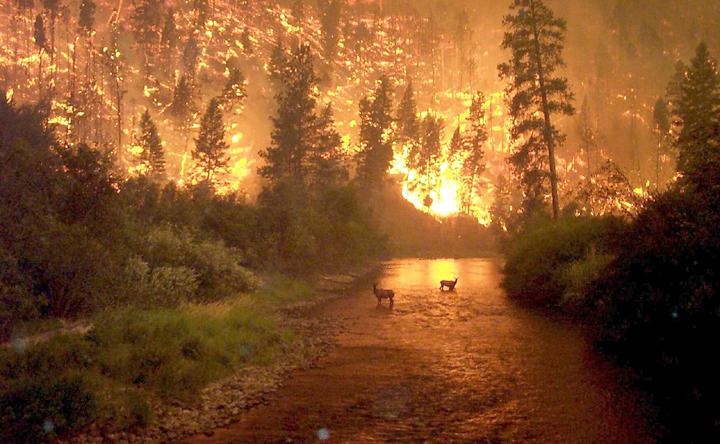Fire Myths
It's a myth that wildfires burn with greater ferocity in wilderness areas than in population zones. That the reverse is true is another myth. What is certain when it comes to wildfire is that environmental elements like wind and drought conditions, along with vegetation, land-management practices, and an area's fire history are the keys to its capacity to burn. These factors weave a complex web, leaving us with very few absolutes or easy explanations—and a whole lot of myths.
Myth: Wildfire is a purely destructive force.
Richard Hutto, Professor of Ecology and Ornithology at University of Montana and a USDA Forest Service Investigator, has written that "fire (and its aftermath) should be seen for what it is: a natural process that creates and maintains much of the variety and biological diversity that we see in the Northern Rockies."
In a study of plant and animal species that depend on postfire habitat, Hutto identified 87 such species. Woodpeckers feed on beetle larvae underneath the bark of standing, fire-killed trees; flycatchers careen through open spaces after insects; and seed eaters take advantage of the abundance of seeds from cones, forbs, and grasses. Standing, fire-killed trees provide nest sites.
Myth: Wildfire has negatively affected tourism in Gallatin County.
"During the 2000 fires, the whole forest was closed but the tourist numbers didn't fall," maintains Phillips. "You just have to deal with it. After all, snow in April chases away tourists, doesn't it?"
Myth: Prescribed burns have the same effect as naturally occurring fires.
Prescribed burns are usually low-intensity affairs in the understories of forests. But Hutto argues that "most of the forested landscape in the Northern Rockies evolved under a regime of high-intensity, large fires every 50 to 100 years." High-intensity, stand-replacement fires provide critical habitat for plant and animal species that low-intensity burns don't replicate.
Myth: Structures are safe from wildfire.
Thinning trees around houses and other buildings and storing wood away from structures can help protect against fire. But fire is a force of nature that tends to follow drought, and since Montana undergoes a drought-flood cycle every five to seven years, fire is simply a risk factor, the way hurricanes threaten the Florida Keys and Kansas experiences tornadoes. You can take precautions to protect your home, but there are no guarantees. And some homes are, simply put, indefensible. "There are a lot of homes in remote areas near Big Sky that the Fire Department says it simply can't defend," says Phillips.
Myth: Fires don't jump roads.
Two of last year's Gallatin County fires debunk this myth. The Purdy fire, 12 miles southwest of Bozeman, scorched 5,000 acres of roaded land and not a single acre of roadless land. The Fridley fire burned approximately 1,500 acres of roaded land. And in fact, according to the Forest Service, fires are almost twice as likely to happen in roaded areas as they are in roadless lands.
Myth: Years of fire suppression has resulted in especially fierce wildfires in the West.
The intervals at which fire naturally recurs are relatively long (sometimes upward of 500 years), but fire suppression tactics (thinning trees, immediately putting out all naturally occurring fires) have only been in use for about 70 years. Therefore, fuel buildup hasn't necessarily had time to occur in many types of forests. Ponderosa pine is one notable exception.
Last year's Fridley fire occurred in stands of Douglas fir, lodgepole pine, subalpine fir, Englemann spruce, and whitebark pine—most of which have long fire-return intervals. "Several land managers and scientists familiar with the Greater Yellowstone Ecosystem...tend to believe that fires such as the Fridley fire are natural events," according to MSU graduate student Crystal Nesbitt.
Myth: Logging prevents or slows wildfire.
History shows that this isn't so. The Purdy and Fridley blazes ripped through a combined 5,000 acres of logged and clear-cut land. In the Fridley fire, says Julie Shea, fire planner for the Gallatin National Forest, some of the harvested areas did help slow the fire, but others did not. The driving force behind that fire, she determined, was wind.
Myth: Salvaging trees from forest fires helps prevent future burns.
"The removal of large, merchantable trees from forests does not reduce fire risk and may, in fact, increase such risk," asserts a report issued in September 2000 by the USDA Forest Service and the Department of the Interior. The Montana Wilderness Association concurs, pointing out that green trees with the potential for survival should always be preserved, along with bigger trees that provide snag habitat, nutrients, and shade. "As a general rule of thumb, 30 percent of the trees should be left in every salvage unit," according to a draft of the organization's salvage policy. Many species depend on the burned habitat for survival.






